 Matthew
Ginder-Vogel1, Wei-Min Wu1, Jack Carley2,
Phillip Jardine2, Scott Fendorf1 and Craig
Criddle1
Matthew
Ginder-Vogel1, Wei-Min Wu1, Jack Carley2,
Phillip Jardine2, Scott Fendorf1 and Craig
Criddle1
1Stanford University, Stanford, CA
2Oak Ridge National Laboratory, Oak Ridge, TN
| 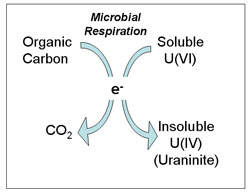 |
|
Figure 1. Uranium(VI) reduction is driven by microbial respiration
resulting in the precipitation of uraninite. |
Uranium contamination of ground and surface waters has been detected at
numerous sites throughout the world, including agricultural evaporation ponds
(1), U.S. Department of Energy nuclear weapons
manufacturing areas, and mine tailings sites (2). In
oxygen-containing groundwater, uranium is generally found in the hexavalent
oxidation state (3,4), which is a
relatively soluble chemical form. As U(VI) is transported through groundwater,
it can bond to surfaces of minerals, a process which may retard its transport
(5-8). It has recently been shown, however,
that U(VI) also bonds strongly to the common groundwater species carbonate and
calcium to form stable dissolved ternary complexes, which can effectively
compete with mineral surfaces as "reservoirs" for U(VI) (9).
As a consequence, significant amounts of U(VI) remain in groundwater, thus
maintaining relatively high mobilities for U(VI), a highly undesirable
scenario. Conversely, the tetravalent oxidation state, U(IV), forms sparingly
soluble solids, even in the presence of dissolved carbonate and calcium, and
thus tends to be relatively immobile. Therefore, the oxidation state of
uranium may play an important role in determining its environmental mobility
(10). Numerous common, dissimilatory metal (DMRB) and
sulfate reducing bacteria (SRB), including Shewanella,
Geobacter, and Desulfovibrio species, couple the oxidation of organic matter
and H2 to the reduction of U(VI), resulting in U(IV) and the subsequent
precipitation of uraninite (UO2) (Figure 1) (11-13), a sparingly soluble phase.
The idea of stimulating these biological processes for the purposes of
stabilizing uranium in the subsurface is therefore promising as a basis for U
remediation technologies, and has been investigated extensively at the beaker
scale (14-16). While so-called bench-top
measurements are valuable for quickly identifying promising research
directions, soils and aquifers are too chemically and hydrologically complex to
be realistically simulated in the laboratory. The long-term stability of
biologically reduced uranium will be determined by the complex interplay of
soil and sediment mineralogy, aqueous geochemistry, microbial activity, and
potential U(IV) oxidants. Many of these factors have been studied under
laboratory conditions; however, the impact of these factors on uranium cycling
in natural, subsurface environments is still poorly understood. It is therefore
essential to complement laboratory-based experiments with careful, long-term
feasibility measurements of U(VI) reduction at contaminated field sites.
| 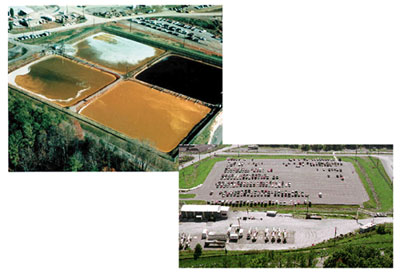 |
|
Figure 2. Former S-3 ponds during decommissioning (top), now a parking lot
(bottom). |
Our pilot-scale uranium bioremediation system located at the Y-12 facility
(Area 3) at the Oak Ridge, TN, Field research center (FRC) provides a
controlled subsurface environment in which these factors can be investigated.
Over the course of 31 years, millions of gallons of plating wastes containing
high concentrations of uranium and nitric acid were generated at this location
and discharged into unlined ponds (the S-3 ponds) (Figure 2). In 1983, the
ponds were capped and converted into a parking lot (Figure 2); however, uranium
contamination remains and continues to migrate through subsurface fractures to
surface discharge points. The U.S. Department of Energy (DOE) has established a
Field Research Center (FRC) to assess the potential uranium immobilization
through the stimulation of native populations of DMRB and SRB.
Since 2001, we have been performing uranium bioremediation experiments in FRC
Area 3, immediately adjacent to the former S-3 Ponds (Figure 3). Prior to our
remediation efforts, the uranium concentration (all in the hexavalent state) in
groundwater at Area 3 was ~210 µM and the sediment contained up to 800 mg
U kg-1 sediment, far in excess of the maximum allowable
| 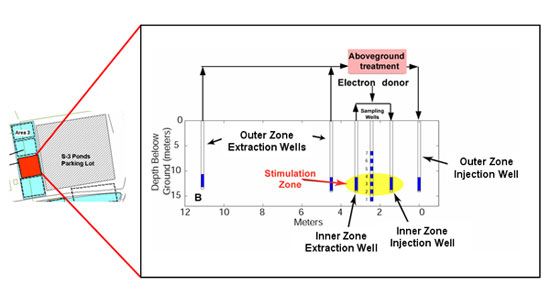 | |
|
Figure 3. Area 3 field site location (left) and well layout (right).
| | | |
concentrations defined by the US EPA. A series of wells were installed at area
3 to control groundwater flow and allow the injection of solutes, such as
ethanol, required to create a geochemical environment conducive for microbial
growth and subsequent U(VI) reduction. The well system consisted of a nested
recirculation system with a protective outer zone to isolate the inner
remediation zone from the ambient geochemical conditions (Figure 3).
Metal-reducing microbial activity in the inner zone was stimulated via ethanol
addition, and dissolved uranium concentrations were monitored in the inner zone
injection and extraction wells, and in a sampling well in the center of the
bioremediation zone (Figure 3). No other such long-term field-scale research
project has been undertaken to evaluate the efficacy of reductive
bioremediation of U(VI) and evaluate how it could be scaled up to treat large
contaminated sites.
| 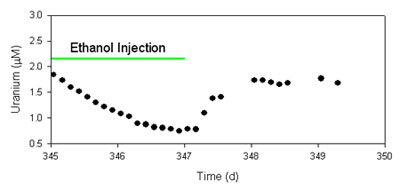 |
|
Figure 4. Representative dissolved U(VI) concentrations in a sampling
well during and after ethanol injection. |
| |
After several months of subsurface conditioning to created a low nitrate,
neutral pH remediation zone (14), microbial uranium reduction
was stimulated by injection of ethanol (1.0 - 1.5 mM) through the inner zone
injection well (Figure 3). During the initial uranium remediation period (185 -
535 d of field site operation), dissolved uranium concentrations in the inner
treatment zone decreased rapidly from 2 µM to <1 µM in response to
ethanol addition, exemplified by Figure 4. Ethanol injection was repeated more
than 50 times during this time period and resulted in similar trends in
dissolved uranium concentration.
Although bacterial reduction of mobile U(VI) to immobile U(IV) is likely the
mechanism responsible for the decrease in dissolved uranium concentration
during ethanol addition, it is critical to confirm bacterial uranium reduction
by measuring uranium's oxidation state in sediment samples. Sediment samples
from the inner treatment zone wells and a sampling well were analyzed using
X-ray absorption near edge structure (XANES) spectroscopy at SSRL Beam Line
11-2. Uranium oxidation state in the sediment samples was determined by
comparison of the U LIII-edge XANES spectra of sediment samples to
U(VI) and U(IV) standards (Figure 5) (17). Prior to
biostimulation, U(IV) was not detectable in the subsurface of Area 3. Sediment
samples were retrieved several times during the initial bioremediation period
(Table 1). Partial reduction of U(IV) was first observed in the inner zone
injection well on day 258, and U(IV) continued to accumulate in this well for
the duration of the experiment (Table 1) Initially, U(IV) was not observed in
the inner zone extraction well; however, by day 535, U(IV) was present
throughout the bioremediation zone (Table 1, Figure 5).
| 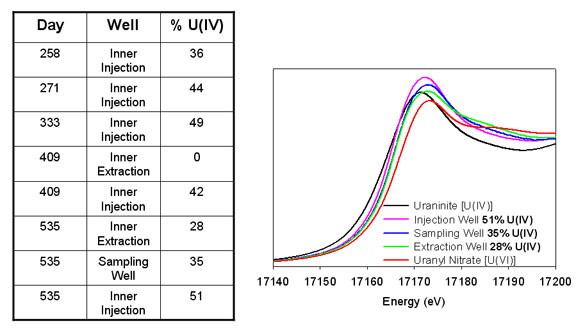 |
|
Figure 5. Uranium(IV) content of sediment samples during the initial
bioremediation period (left) and uranium LIII-edge XANES spectra from sediment
retrieved on day 535 (right). |
Microbial activity has produced low dissolved uranium concentrations and high
proportions of solid-phase U(IV) throughout the subsurface system remediation
system. Continued biostimulation has resulted in groundwater uranium
concentrations below the U.S. Environmental Protection Agency's drinking water
standards (0.126 µM). Current research is examining the long-term
stability of biologically reduced uranium, particularly in the presence of
potential oxidants, including molecular oxygen (18). The
long-term goal of this project is to decrease the flux of uranium leaving the
site to the point that it is harmless.
This work was supported by the US DOE, Office of Biological and Environmental
Remediation Program (ERSP) under grant DOEAC05-00OR22725. Portions of this
research were carried out at the Stanford Synchrotron Radiation Laboratory, a
national user facility operated by Stanford University on behalf of the U.S.
DOE, Office of Basic Energy Sciences. Environmental remediation sciences
research at SSRL is supported by the ERSP support program.
Primary Citation
W.-M. Wu, W.-M.; Carley, J.; Gentry, T.; Ginder-Vogel, M. A.; M. Fienen, M.;
Mehlhorn, T.; Yan, H.; Carroll, S.; Pace, M. N.; Nyman, J.; Luo, J.; Gentile,
M. E.; Fields, M. W.; Hickey, R. F.; Gu, B.; Watson, D.; Cirpka, O. A.; Zhou,
J.; Fendorf, S.; Kitanidis, P. K.; Jardine, P. M.; Criddle, C. S. "Pilot-scale
in situ bioremediation of uranium in a highly contaminated aquifer. 2.
Reduction of U (VI) and geochemical control of U(VI) bioavailability", Environ.
Sci. Technol. 2006, 40, 3986.
References
-
Bradford, G. R.; Bakhtar, D.; Westcot, D. Uranium, vanadium, and molybdenum in
saline waters of California. Journ. Environ. Qual. 1990, 19, 105-108.
-
Riley, R. G.; Zachara, J. M.; Wobber, F. J. "Chemical contaminants on DOE lands
and selection of contaminant mixtures for subsurface science research," U.S.
Department of Energy, 1992.
- Langmuir, D. Uranium solution-mineral equilibria at low temperature
with applications to sedimentary ore deposits. Geochim. Cosmochim. Acta
1978, 42, 547-569.
- Sandino, A.; Bruno, J. The solubility of
(UO2)3(PO4)2·4H2O(s) and
the formation of U(VI) phospate complexes: Their influence in uranium
speciation in natural waters. Geochim. Cosmochim. Acta 1992, 56, 4135-4145.
-
Moyes, L. N.; Parkman, R. H.; Charnock, J. M.; Vaughan, D. J.; Livens, F. R.;
Hughes, C. R.; Braithwaite, A. Uranium uptake from aqueous solution by
interaction with goethite, lepidocrocite, muscovite, and mackinawite: An x-ray
absorption spectroscopy study. Environ. Sci. Technol. 2000, 34, 1062-1068.
-
Bostick, B. B.; Fendorf, S.; Barnett, M. O.; Jardine, P. M.; Brooks, S. C.
Uranyl surface complexes formed on subsurface media from DOE facilities. Soil
Sci. Soc. Am. J. 2002, 66, 99-108.
-
Barnett, M. O.; Jardine, P. M.; Brooks, S. C.; Selim, H. M. Adsorption and
transport of uranium(VI) in subsurface media. Soil Sci. Soc. Am. J.
2000, 64, 908-917.
-
Barnes, C. E.; Cochran, J. K. Uranium geochemistry in esturaine sediments:
Controls on removal and release processes. Geochim. Cosmochim. Acta
1993, 57, 555-569.
-
Grenthe, I.; Fuger, J.; Konings, R. J. M.; Lemire, R. J.; Muller, A. B.;
Nguyen-Trung, C.; Wanner, H. Chemical thermodynamics of uranium; North-Holland
Elsevier Science Publishers B.V.: Amsterdam, 1992; Vol. 1.
-
Liger, E.; Charlet, L.; Cappellen, P. V. Surface catalysis of uranium(VI)
reduction by iron(II). Geochim. Cosmochim. Acta 1999, 63, 2939-2955.
-
Fredrickson, J. K.; Zachara, J. M.; Kennedy, D. W.; Duff, M. C.; Gorby, Y. A.;
Li, S. M. W.; Krupka, K. M. Reduction of U(VI) in goethite (a-FeOOH)
suspensions by a dissimilatory metal-reducing bacterium. Geochim. Cosmochim.
Acta 2000, 64, 3085-3098.
-
Lovely, D. R.; Phillips, E. J. P. Bioremediation of uranium contamination with
enzymatic uranium reduction. Environ. Sci. Technol. 1992, 26,
2228-2234.
-
Gorby, Y. A.; Lovley, D. R. Enzymatic uranium precipitation. Environ. Sci.
Technol. 1992, 26, 205-207.
-
Wu, W.-M.; Carley, J.; Fienen, M.; Mehlhorn, T.; Lowe, K.; Nyman, J.; Luo, J.;
Gentile, M.; Rajan, R.; Wagner, D.; Hickey, R.; Gu, B.; Watson, D. B.; Cirpka,
O.; Kitanidis, P.; Jardine, P. M.; Criddle, C. Pilot-scale in situ
bioremediation of uranium in a highly contaminated aquifer. 1. Conditioning of
a treatment zone. Environ. Sci. Technol. 2006, 40, 3978-3985.
-
Wu, W.-M.; Carley, J.; Gentry, T.; Ginder-Vogel, M.; Fienen, M.; Mehlhorn, T.;
Yan, H.; Caroll, S.; Pace, M.; Nyman, J.; Luo, J.; Gentile, M.; Fields, M. W.;
Hickey, R.; Watson, D. B.; Cirpka, O.; Zhou, J.; Fendorf, S.; Kitanidis, P.;
Jardine, P. M.; Criddle, C. Pilot-scale in situ bioremediation of uranium in a
highly contaminated aquifer. 2. Geochemical control of U(VI) bioavailability
and evidence of U(VI) reduction. Environ. Sci. Technol. 2006, 40, 3986-3995.
-
Anderson, R. T.; Vrionis, H. A.; Ortiz-Bernard, I.; Resch, C. T.; Long, P. E.;
Dayvault, R.; Karp, K.; Marutzky, S.; Metzler, D. R.; Peacock, A. D.; White, D.
C.; Lowe, M.; Lovley, D. R. Stimulating the in situ activity of Geobacter
species to remove uranium from the groundwater of a uranium-contaminated
aquifer. Appl. Environ. Microb. 2003, 69, 5884-5891.
-
Bertsch, P. M.; Hunter, D. B. In situ chemical speciation of uranium in
soils
and sediments by micro x-ray absorption spectroscopy. Environ. Sci.
Technol. 1994, 28, 980-984.
-
Wu, W.-M.; Carley, J.; Luo, J.; Ginder-Vogel, M.; Cardanans,
E.; Leigh, M. B.; Hwang, C.; Kelly, S. D.; Ruan, C.; Wu, L.; Gentry, T.; Lowe,
K.; Mehlhorn, T.; Carroll, S. L.; Fields, M. W.; Gu, B.; Watson, D.; Kemner, K.
M.; Marsh, T. L.; Tiedje, J. M.; Zhou, J.; Fendorf, S.; Kitanidis, P.; Jardine,
P. M.; Criddle, C. In situ bioreduction of uranium(VI) to submicromolar levels
and reoxidation by dissolved oxygen. Environ. Sci. Technol. 2006, Submitted.
|
| PDF
Version | | Lay Summary | |
Highlights Archive
|
| SSRL is supported
by the Department of Energy, Office of Basic Energy Sciences. The SSRL
Structural Molecular Biology Program is supported by the Department of Energy,
Office of Biological and Environmental Research, and by the National Institutes
of Health, National Center for Research Resources, Biomedical Technology
Program, and the National Institute of General Medical Sciences. |
|

 Matthew
Ginder-Vogel1, Wei-Min Wu1, Jack Carley2,
Phillip Jardine2, Scott Fendorf1 and Craig
Criddle1
Matthew
Ginder-Vogel1, Wei-Min Wu1, Jack Carley2,
Phillip Jardine2, Scott Fendorf1 and Craig
Criddle1



